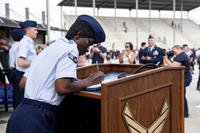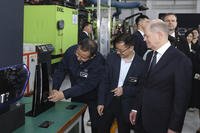Keeping count of the U.S. Air Force's nuclear capable bombers under the New Strategic Arms Reduction Treaty with Russia is a tricky business. The treaty stipulates the number of nuclear capable bombers, submarine launched ballistic missiles and inter-continental ballistic missiles the U.S. military keeps in a deployed and non-deployed status.
This goes for bombers that are not even fit to fly. There is a whole set of phantom bombers that are listed under the New START Treaty even though they are left to rot at the boneyard at Davis Monthan Air Force Base, Ariz.
The U.S. Air Force has started the process of either retiring or converting the phantom bomber to meet limits set in the treaty by 2018. The U.S. Air Force does not pay extra for these bombers to be counted under the treaty. There is not additional maintenance that is provided to them, said said Air Force Col. Norman Worthen is the Division Chief for Nuclear Planning, Policy, and Strategy.
Quite the contrary. The Air Force actually is saving money by not disassembling these bombers to take away their nuclear capability. Bombers are defined as nuclear capable simply by the capability of deploying a nuclear weapon.
In a post titled "Phantom bombers weigh down military budget" that appeared on DoDBuzz on Dec. 27, I incorrectly wrote that the Air Force unnecessarily spends additional money to keep these bombers listed as nuclear capable.
The bill will eventually come due as the U.S. Air Force will have to reduce its number of nuclear capable bombers by 2018 in line with the treaty requirements. However, for now, the costs are the same whether the bombers are nuclear capable or not, Worthen said.
New START, signed by U.S. and Russian leaders in 2010, states that each country must reduce its number of deployed and non-deployed strategic delivery vehicle fleet to 800 by 2018. Each country must also only have 700 deployed strategic delivery vehicles to 700 by 2018.
To coincide with the New START limits, the U.S. Air Force plans to reduce its nuclear capable bomber fleet to 60. Upon it's signing in 2010, the Air Force was left to either retire or convert 145 bombers that were considered nuclear capable under the old START by 2018.
Air Force leaders have thus far made significant progress by reducing the number of bombers it needs to either retire or convert to 37: 24 B-52 Gs and 13 B-52 Hs. A large chunk of the 145 bombers were converted when the B-1 fleet was converted to a non-nuclear role.
Worthen said the Air Force is continuing to work toward the goal of 60 bombers. He expects it to be completed ahead of the 2018 deadline.








